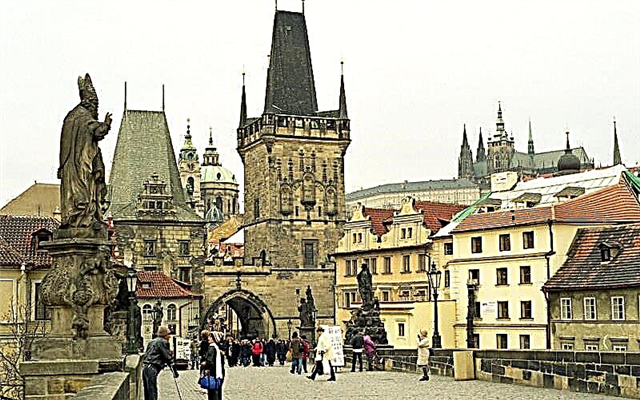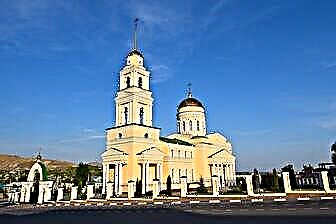Location: Portugal, Lisbon
Architect: Diogo de Boytaca, Diego de Toralva, Nicola Chantherin
Foundation date: 1450 BC
Coordinates: 38 ° 41'50.9 "N 9 ° 12'25.1" W
Content:
Jeronimos Monastery is the most beautiful and oldest monument in Portugal. This monastery is one of the must-see attractions in Lisbon. This is a building, entering which, you plunge into the era of kings.

Jeronimos Monastery from a bird's eye view
Historical data
The monastery was erected at the beginning of the 16th century at the request and order of King Manuel I of Portugal. The construction of the monastery continued throughout the 16th century.... The building of the monastery with a facade of three hundred meters in length, not only in those days, however, and today is considered a huge structure. This is a real treasure, built in the Manueline style, the name of which is associated with the name of the king himself. Construction turned out to be quite an expensive pleasure and the king had to spend large sums annually.
The main material for construction - limestone was mined nearby, in the Ajuda region, in the Alcantara valley. Monks of the Jeronimos Order or, in another name, the Hieronymus Order, were settled in the monastery, who also served the monastery. These monks served a daily mass for the king and his followers, and also provided spiritual assistance to sailors and sailors who set out on voyages to explore other worlds. They were well educated, engaged in reading, studied grammar, religious morality and sacred music.

General view of the monastery
In 1755, during the famous Lisbon earthquake, the monastery building survived. The collapsed parts were quickly rebuilt. Interestingly, after the earthquake, the tidal wave of the Tagus River, on the banks of which the building is located, brought a large amount of sand, thanks to which the monastery was at a very close distance from the water, about several hundred meters. Although, before the earthquake, the Jeronimos monastery was practically near the water. Even the Belenskaya Tower, which was in the middle of the river, is now on the bank.
In 1833, according to the law, the existence of religious orders in Portugal was prohibited, so the community was disbanded, and the monastery was given to the royal orphanage for children of orphans and homeless, which exists to this day and is located along the street, not far from the monastery. Despite the status of the monastery, it gradually becomes a dilapidated structure that requires repair. At the beginning of the 20th century, it was restored, the dome was completed, the decorations in the Manueline style were renewed, after which the monastery acquired the appearance that can be observed today.

In the center is the entrance to the National Archaeological Museum
An architectural masterpiece
The architecture is presented from elements of the late Gothic and Renaissance, associated with the royal symbols and symbols of Christianity, as well as with the surrounding nature. This combination is unique and makes the architecture of the monastery worthy of admiration. This style is characterized by the use of complex sculptural details, as well as the use of marine motifs. The columns of the building are decorated with carved coils of rope, images of sea monsters, corals and other marine elements. This architectural monument combines a massive and simple Romanesque cubic volume with protruding Gothic vaults. At the main entrance to the monastery building there is a statue of Heinrich the Navigator. The entrance to the former refectory is decorated with a beautiful mesh vault and sculptures depicting Joseph's biblical stories. A certain part of the monastery complex is occupied by the chapel of St. Jerome, built in 1514.

View of the northern facade of the monastery
This chapel has a conical dome, decorated with a stone "rope" along the roof, and gargoyles at the corners. Outside the monastery, a garden was laid out, which consists of hedges and in the center of which is a large fountain, decorated with the municipal coats of arms of Portugal and illuminated by multicolored spotlights. The National Archaeological Museum is located in the western part of the monastery.
The collection of the museum offers ethnographic and archaeological finds for study: ceramics, sculpture, mosaics, Celtic gold and silver jewelry, as well as ancient Egyptian finds. In the premises of the monastery, you can visit an exhibition that will acquaint you with the history of the Jeronimos monastery in English and Portuguese. The Jeronimos Monastery is a World Heritage Site, included in the UNESCO list of cultural property in 1983. This is a significant state facility, where in 1984 an agreement was signed on Portugal's accession to the European Union. Russian President Vladimir Putin visited the monastery in October 2007.

Entrance to the Maritime Museum
The Jeronimos Monastery is the most outstanding Gothic monument, which has been recognized as one of the Seven Wonders of Portugal. The craftsmen participating in the construction of this temple have created an unusual structure of fantastic appearance. This temple, founded during the period of the Great Geographical Discoveries, became the last refuge of Vasco da Gama, who in 1497 opened the sea route to India, kings Manuel I and João III and other famous people.











